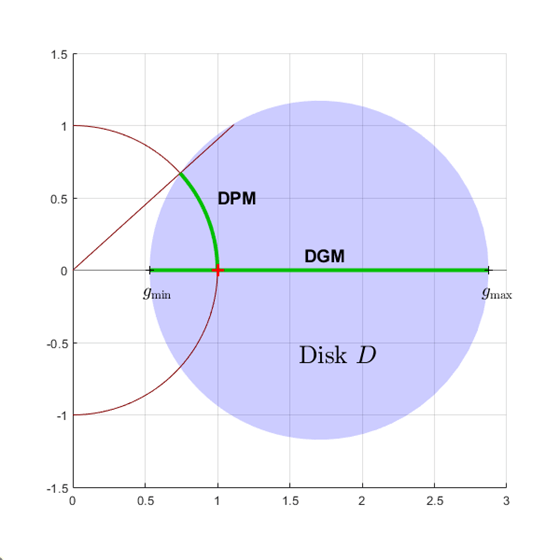getDGM
Convert gain and phase variation into disk-based gain variation
Description
In disk margin analysis, gain and phase variations are modeled as a factor
F(s) multiplying the open loop response
L(s). This factor takes values in a disk
D centered on the real axis with real-axis intercepts
gmin and gmax. The disk margin determines the largest
disk size [gmin,gmax] for which the feedback loop remains stable. This
provides a gain margin of at least DGM = [gmin,gmax] and also some phase
margin DPM determined by the disk geometry.

Conversely, getDGM takes desired gain and phase margins
GM and PM and computes the smallest disk
D that delivers both. This disk is characterized by its real-axis
intercepts gmin, gmax and the corresponding disk-based
gain margin DGM = [gmin,gmax] and phase margin DPM meet
or exceed GM and PM.
For more information about the disk model of gain and phase variation, see Algorithms.
DGM = getDGM(GM,PM,'tight')GM and PM.
If
GMandPMare scalars, then the disk captures gain that can increase or decrease by a factor ofGM, and phase that can increase or decrease byPM.If
GMandPMare vectors of the form[glo,ghi]and[pmin,pmax]then the disk captures relative gain and phase variations in these ranges.If either
GMorPMis[], that removes the corresponding constraint on the disk size.
The output is of the form DGM = [gmin,gmax], and
describes a disk that represents absolute gain variations within that range. For instance,
DGM = [0.8,1.8] models gain that can vary from 0.8 times the nominal
value to 1.8 times the nominal value, and phase variations determined by the disk geometry.
This disk might have non-zero skew (see Algorithms). Use
DGM to create a umargin block that models these gain
and phase variations.
DGM = getDGM(GM,PM,'balanced')DGM = [gmin,gmax] where gmin =
1/gmax. This disk has zero skew (see Algorithms).
Examples
Input Arguments
Output Arguments
Algorithms
umargin and
diskmargin model
gain and phase variations in an individual feedback channel as a frequency-dependent
multiplicative factor F(s) multiplying the nominal
open-loop response L(s), such that the perturbed
response is
L(s)F(s). The
factor F(s) is parameterized by:
In this model,
δ(s) is a gain-bounded dynamic uncertainty, normalized so that it always varies within the unit disk (||δ||∞ < 1).
ɑ sets the amount of gain and phase variation modeled by F. For fixed σ, the parameter ɑ controls the size of the disk. For ɑ = 0, the multiplicative factor is 1, corresponding to the nominal L.
σ, called the skew, biases the modeled uncertainty toward gain increase or gain decrease.
The factor F takes values in a disk centered on the real axis and
containing the nominal value F = 1. The disk is characterized by its
intercept DGM = [gmin,gmax] with the real axis. gmin
< 1 and gmin > 1 are the minimum and maximum relative changes in gain
modeled by F, at nominal phase. The phase uncertainty modeled by
F is the range DPM = [-pm,pm] of phase values at the
nominal gain (|F| = 1). For instance, in the following plot, the right side
shows the disk F that intersects the real axis in the interval [0.71,1.4].
The left side shows that this disk models a gain variation of ±3 dB and a phase variation of
±19°.
DGM = [0.71,1.4]
F = umargin('F',DGM)
plot(F)
getDGM converts the target gain and phase variations that you want to
model into the disk-based gain-variation range DGM. This range fully
characterizes the disk F. The corresponding phase range
DPM is thus determined by DGM and the disk model.
For further details about the uncertainty model for gain and phase variations, see Stability Analysis Using Disk Margins.
Version History
Introduced in R2020a





![Uncertainty disk characterized by DGM = [0.5,2]](disk_dgm_argdesc.png)